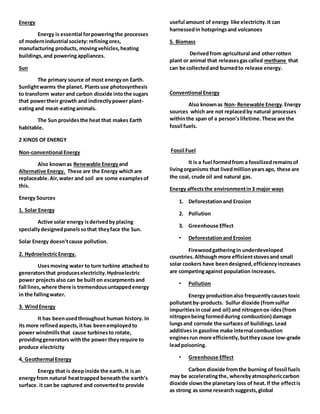
Energy and Engineering Projects
- 1. Energy Energy is essential forpoweringthe processes of modernindustrial society: refiningores, manufacturing products, movingvehicles,heating buildings,and poweringappliances. Sun The primary source of most energyon Earth. Sunlightwarms the planet. Plantsuse photosynthesis to transform water and carbon dioxide intothe sugars that powertheir growth and indirectlypower plant- eatingand meat-eatinganimals. The Sun providesthe heat that makes Earth habitable. 2 KINDS OF ENERGY Non-conventional Energy Also knownas Renewable Energyand Alternative Energy. These are the Energy whichare replaceable.Air,water and soil are some examplesof this. Energy Sources 1. Solar Energy Active solar energy isderivedby placing speciallydesignedpanelssothat theyface the Sun. Solar Energy doesn'tcause pollution. 2. HydroelectricEnergy. Usesmoving water to turn turbine attached to generatorsthat produceselectricity.Hydroelectric power projectsalso can be built on escarpmentsand fall lines,where there is tremendousuntappedenergy in the fallingwater. 3. WindEnergy It has beenusedthroughout human history. In its more refinedaspects,ithas beenemployedto power windmillsthat cause turbinesto rotate, providinggenerators withthe power theyrequire to produce electricity 4. Geothermal Energy Energy that is deepinside the earth. It isan energyfrom natural heattrapped beneaththe earth’s surface. it can be captured and convertedto provide useful amount of energy like electricity.It can harnessedin hotspringsand volcanoes 5. Biomass Derivedfrom agricultural and otherrotten plant or animal that releasesgascalled methane that can be collectedand burnedto release energy. Conventional Energy Also knownas Non- Renewable Energy.Energy sources which are not replacedby natural processes withinthe span of a person’slifetime.These are the fossil fuels. Fossil Fuel It is a fuel formedfrom a fossilizedremainsof livingorganisms that livedmillionyearsago, these are the coal, crude oil and natural gas. Energy affectsthe environmentin3 major ways 1. Deforestationand Erosion 2. Pollution 3. Greenhouse Effect • Deforestationand Erosion Firewoodgatheringin underdeveloped countries.Although more efficientstovesand small solar cookers have beendesigned,efficiencyincreases are competingagainst population increases. • Pollution Energy productionalso frequentlycausestoxic pollutantby-products. Sulfur dioxide (fromsulfur impuritiesincoal and oil) and nitrogenox-ides(from nitrogenbeingformedduring combustion) damage lungsand corrode the surfaces of buildings.Lead additivesin gasoline make internal combustion enginesrun more efficiently,buttheycause low-grade leadpoisoning. • Greenhouse Effect Carbon dioxide fromthe burning of fossil fuels may be acceleratingthe, wherebyatmosphericcarbon dioxide slowsthe planetary loss of heat.If the effectis as strong as some research suggests,global
- 2. temperaturesmay increase several degreeson average in the Twenty-firstcentury, with unknowneffectson climate and sealevel. ENGINEERING PROJECTS 1. Dams Dams serve several purposes. 1. the generationofhydroelectricpower. 2. Dams also provide floodcontrol and irrigation. 3. Flood-control dams also can be usedto regulate the flowof water usedfor irrigation and other projects. 2. Bridges Bridgesare builtto span low-lyingland betweentwo high places.Most commonly,there isa river or other body of water in the way, but other featuresthat might be spanned include ravines,deepvalleys and trenches,and swamps. A relatedengineeringprojectis the causeway, in which land in a low-lyingarea is built up and a road is then constructed on it. The longest bridge in the world isthe Akashi Kaikyo in Japan near Osaka. It was built in1998 and spans 6,529 feet(1,990 meters),connectingthe island of Honshw to the small islandof Awaji. 3. Canals Movinggoods and people by water is generally cheaperand easier,ifa bit slower,than movingthem by land. Before the twentiethcentury,that cost savings overwhelmedthe advantagesof land travel— speedand versatility.Therefore,humanbeingshave wanted to move things by water wheneverpossible. To do so,they had two choices:locate factories and people nearwater, such as rivers,lakes,and oceans,or bring water to where the factoriesand people are,by diggingcanals. The longestcanal in the world isthe Grand Canal in China,which was builtin the seventhcentury and stretchesa lengthof 1,085 miles(2,904 km.) The long and dangerous sea journeyaround the tip of South America. The SuezCanal in Egypt, which runs for 100 miles(162 km.) 4. Tunnels Tunnelsconnect two placesseparated by physical featuresthat wouldmake it extremelydifficult,ifnot impossible,forthemto be connectedwithout cutting directlythrough them. Tunnelscan be usedin place of bridgesover water bodiesso that water traffic isnot impededbya bridge span. Tunnelsare oftenused to go through mountains that might be too tall to climbover. Trains especiallyare sensitive tochanges in slope,and train tunnelsare foundall over the world.Less common are automobile and truck tunnels,althoughthese are also found in many places. The Chunnel.Arguablythe most famous—andone of the most ambitious—tunnelsinthe worldgoes by the name Chunnel.Completedin1994, it connects Dover, England, to Calais,France, and runs 31 miles(50km.). 5. Buildings Historically,North America has beenhome to the tallestbuildingsinthe world. Chicago has beencalled the birthplace of the sky- scraper and was at one time home to the world’s tallestbuilding. The tallestof the city’s buildingswere the twin towers of the WorldTrade Centerin Lower Manhattan.
